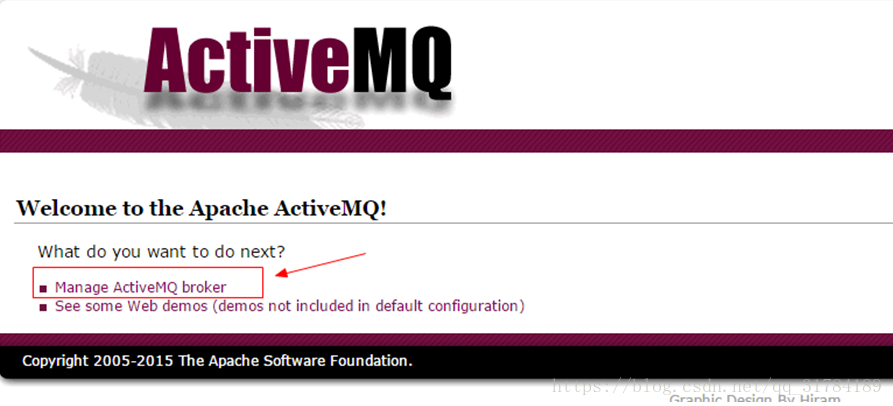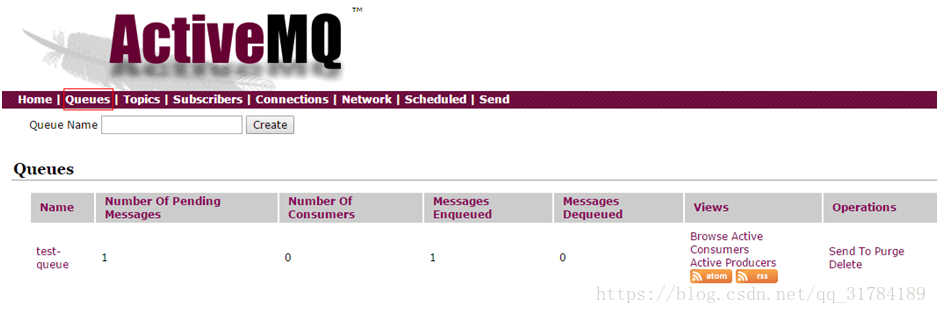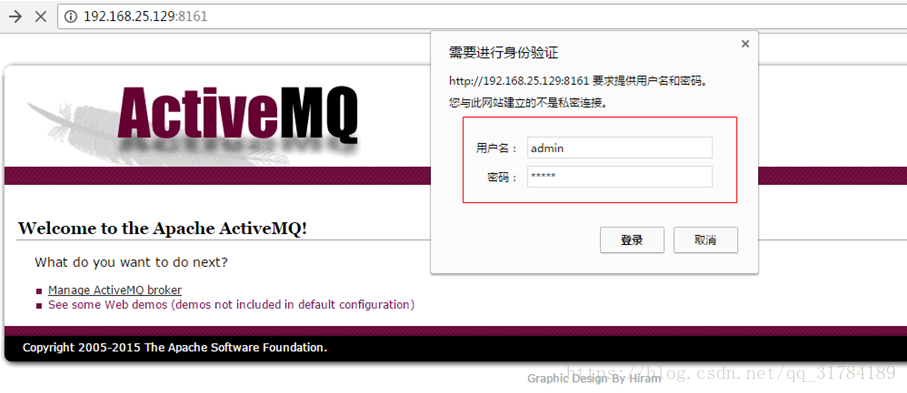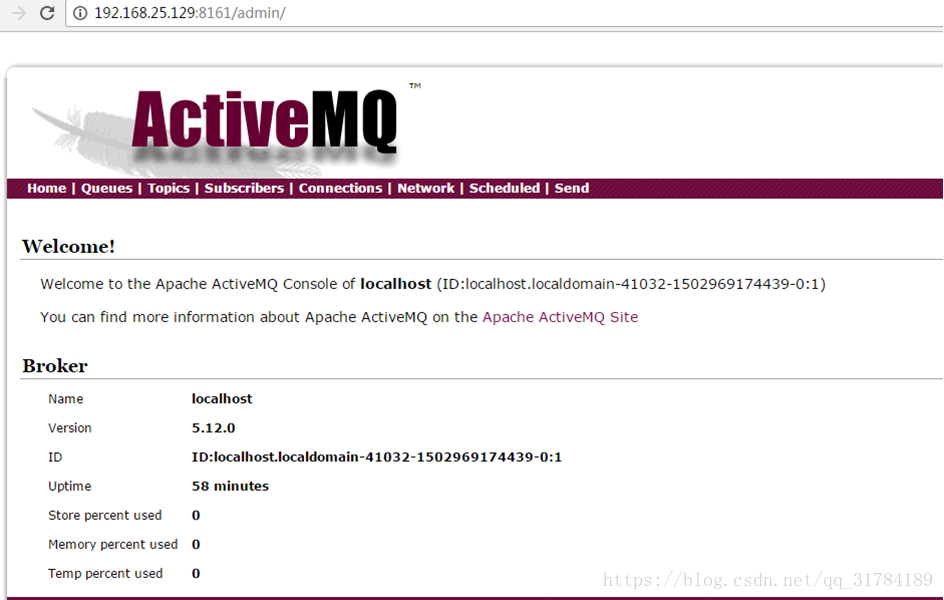消息中间件解决方案JMS
1、什么是消息中间件
消息中间件利用高效可靠的消息传递机制进行平台无关的数据交流,并基于数据通信来进行分布式系统的集成。通过提供消息传递和消息排队模型,它可以在分布式环境下扩展进程间的通信。对于消息中间件,常见的角色大致也就有Producer(生产者)、Consumer(消费者)
常见的消息中间件产品
(1)ActiveMQ
ActiveMQ 是Apache出品,最流行的,能力强劲的开源消息总线。ActiveMQ 是一个完全支持JMS1.1和J2EE 1.4规范的 JMS Provider实现。我们在本次课程中介绍 ActiveMQ的使用。
(2)RabbitMQ
AMQP协议的领导实现,支持多种场景。淘宝的MySQL集群内部有使用它进行通讯,OpenStack开源云平台的通信组件,最先在金融行业得到运用。
(3)ZeroMQ
史上最快的消息队列系统
(4)Kafka
Apache下的一个子项目 。特点:高吞吐,在一台普通的服务器上既可以达到10W/s的吞吐速率;完全的分布式系统。适合处理海量数据。
2、JMS简介
2.1、什么是JMS
JMS(Java Messaging Service)是Java平台上有关面向消息中间件的技术规范,它便于消息系统中的Java应用程序进行消息交换,并且通过提供标准的产生、发送、接收消息的接口简化企业应用的开发。
JMS本身只定义了一系列的接口规范,是一种与厂商无关的 API,用来访问消息收发系统。它类似于 JDBC(java Database Connectivity):这里,JDBC 是可以用来访问许多不同关系数据库的 API,而 JMS 则提供同样与厂商无关的访问方法,以访问消息收发服务。许多厂商目前都支持 JMS,包括 IBM 的 MQSeries、BEA的 Weblogic JMS service和 Progress 的 SonicMQ,这只是几个例子。 JMS 使您能够通过消息收发服务(有时称为消息中介程序或路由器)从一个 JMS 客户机向另一个 JML 客户机发送消息。消息是 JMS 中的一种类型对象,由两部分组成:报头和消息主体。报头由路由信息以及有关该消息的元数据组成。消息主体则携带着应用程序的数据或有效负载。
JMS 定义了五种不同的消息正文格式,以及调用的消息类型,允许你发送并接收以一些不同形式的数据,提供
现有消息格式的一些级别的兼容性。
· TextMessage--一个字符串对象
· MapMessage--一套名称-值对
· ObjectMessage--一个序列化的 Java 对象
· BytesMessage--一个字节的数据流
· StreamMessage -- Java 原始值的数据流
2.2、JMS消息传递类型
对于消息的传递有两种类型
一种是点对点的,即一个生产者和一个消费者一一对应。
另一种是发布/ 订阅模式,即一个生产者产生消息并进行发送后,可以由多个消费者进
行接收。

3、ActiveMQ下载与安装
3.1、官方网站下载
官方网站下载:http://activemq.apache.org/
3.2、安装(Linux)
(1)将apache-activemq-5.12.0-bin.tar.gz 上传至服务器
(2)解压此文件
tar zxvf apache-activemq-5.12.0-bin.tar.gz
(3)为apache-activemq-5.12.0目录赋权
chmod 777 apache-activemq-5.12.0
(6)启动
./activemq start
出现下列提示表示成功!

假设服务器地址为192.168.25.135 ,打开浏览器输入地址
http://192.168.25.135:8161/ 即可进入ActiveMQ管理页面

点击进入管理页面

输入用户名和密码 均为 admin
进入主界面
点对点消息队列

列表各列含义
Number Of Pending Messages :等待消费的消息 这个是当前未出队列的数量。
Number Of Consumers :消费者 这个是消费者端的消费者数量
Messages Enqueued :进入队列的消息 进入队列的总数量,包括出队列的。
Messages Dequeued :出了队列的消息 可以理解为是消费这消费掉的数量。
4、JMS小Demo
4.1、点对点模式
点对点的模式主要建立在一个队列上面,当连接一个列队的时候,发送端不需要知道接收端是否正在接收,可以直接向ActiveMQ发送消息,发送的消息,将会先进入队列中,如果有接收端在监听,则会发向接收端,如果没有接收端接收,则会保存在activemq服务器,直到接收端接收消息,点对点的消息模式可以有多个发送端,多个接收端,但是一条消息,只会被一个接收端给接收到,哪个接收端先连上ActiveMQ,则会先接收到,而后来的接收端则接收不到那条消息。
4.2、消息生产者
(1)创建工程jmsDemo ,引入依赖
<dependency> <groupId>org.apache.activemq</groupId> <artifactId>activemq-client</artifactId> <version>5.13.4</version> </dependency>
(2)创建类QueueProducer main方法代码如下:
//1.创建连接工厂 ConnectionFactory connectionFactory=new ActiveMQConnectionFactory("tcp://192.168.25.135:61616"); //2.获取连接 Connection connection = connectionFactory.createConnection(); //3.启动连接 connection.start(); //4.获取session (参数1:是否启动事务,参数2:消息确认模式) Session session = connection.createSession(false, Session.AUTO_ACKNOWLEDGE); //5.创建队列对象 Queue queue = session.createQueue("test-queue"); //6.创建消息生产者 MessageProducer producer = session.createProducer(queue); //7.创建消息 TextMessage textMessage = session.createTextMessage("欢迎来到神奇的品优购世界"); //8.发送消息 producer.send(textMessage); //9.关闭资源 producer.close(); session.close(); connection.close(); 上述代码中第4步创建session 的两个参数:
第1个参数 是否使用事务
第2个参数 消息的确认模式
• AUTO_ACKNOWLEDGE = 1 自动确认
• CLIENT_ACKNOWLEDGE = 2 客户端手动确认
• DUPS_OK_ACKNOWLEDGE = 3 自动批量确认
• SESSION_TRANSACTED = 0 事务提交并确认
运行后通过ActiveMQ管理界面查询 
4.3、消息消费者
创建类QueueConsumer ,main方法代码如下:
//1.创建连接工厂 ConnectionFactory connectionFactory=new ActiveMQConnectionFactory("tcp://192.168.25.135:61616"); //2.获取连接 Connection connection = connectionFactory.createConnection(); //3.启动连接 connection.start(); //4.获取session (参数1:是否启动事务,参数2:消息确认模式) Session session = connection.createSession(false, Session.AUTO_ACKNOWLEDGE); //5.创建队列对象 Queue queue = session.createQueue("test-queue"); //6.创建消息消费 MessageConsumer consumer = session.createConsumer(queue); //7.监听消息 consumer.setMessageListener(new MessageListener() { public void onMessage(Message message) { TextMessage textMessage=(TextMessage)message; try { System.out.println("接收到消息:"+textMessage.getText()); } catch (JMSException e) { // TODO Auto-generated catch block e.printStackTrace(); } } }); //8.等待键盘输入 System.in.read(); //9.关闭资源 consumer.close(); session.close(); connection.close(); 执行后看到控制台输出

运行测试
同时开启2个以上的消费者,再次运行生产者,观察每个消费者控制台的输出,会发现只有一个消费者会接收到消息。
5、发布/订阅模式
5.1、消息生产者
创建类TopicProducer ,main方法代码如下:
//1.创建连接工厂 ConnectionFactory connectionFactory=new ActiveMQConnectionFactory("tcp://192.168.25.135:61616"); //2.获取连接 Connection connection = connectionFactory.createConnection(); //3.启动连接 connection.start(); //4.获取session (参数1:是否启动事务,参数2:消息确认模式) Session session = connection.createSession(false, Session.AUTO_ACKNOWLEDGE); //5.创建主题对象 Topic topic = session.createTopic("test-topic"); //6.创建消息生产者 MessageProducer producer = session.createProducer(topic); //7.创建消息 TextMessage textMessage = session.createTextMessage("欢迎来到神奇的品优购世界"); //8.发送消息 producer.send(textMessage); //9.关闭资源 producer.close(); session.close(); connection.close(); 运行效果 
5.2、消息消费者
创建类TopicConsumer ,main方法代码如下:
//1.创建连接工厂 ConnectionFactory connectionFactory=new ActiveMQConnectionFactory("tcp://192.168.25.135:61616"); //2.获取连接 Connection connection = connectionFactory.createConnection(); //3.启动连接 connection.start(); //4.获取session (参数1:是否启动事务,参数2:消息确认模式) Session session = connection.createSession(false, Session.AUTO_ACKNOWLEDGE); //5.创建主题对象 //Queue queue = session.createQueue("test-queue"); Topic topic = session.createTopic("test-topic"); //6.创建消息消费 MessageConsumer consumer = session.createConsumer(topic); //7.监听消息 consumer.setMessageListener(new MessageListener() { public void onMessage(Message message) { TextMessage textMessage=(TextMessage)message; try { System.out.println("接收到消息:"+textMessage.getText()); } catch (JMSException e) { // TODO Auto-generated catch block e.printStackTrace(); } } }); //8.等待键盘输入 System.in.read(); //9.关闭资源 consumer.close(); session.close(); connection.close(); 5.3、运行测试
同时开启2个以上的消费者,再次运行生产者,观察每个消费者控制台的输出,会发现每个消费者会接收到消息。
6、Spring整合JMS
6.1、点对点模式
消息生产者
(1)创建工程springjms_producer,在POM文件中引入SpringJms 、activeMQ以及单元测试相关依赖
(2)在src/main/resources下创建spring配置文件applicationContext-jms-producer.xml
<context:component-scan base-package="cn.itcast.demo"></context:component-scan><!-- 真正可以产生Connection的ConnectionFactory,由对应的 JMS服务厂商提供--> <bean id="targetConnectionFactory" class="org.apache.activemq.ActiveMQConnectionFactory"> <property name="brokerURL" value="tcp://192.168.25.135:61616"/> </bean><!-- Spring用于管理真正的ConnectionFactory的ConnectionFactory --> <bean id="connectionFactory" class="org.springframework.jms.connection.SingleConnectionFactory"> <!-- 目标ConnectionFactory对应真实的可以产生JMS Connection的ConnectionFactory --> <property name="targetConnectionFactory" ref="targetConnectionFactory"/> </bean> <!-- Spring提供的JMS工具类,它可以进行消息发送、接收等 --> <bean id="jmsTemplate" class="org.springframework.jms.core.JmsTemplate"> <!-- 这个connectionFactory对应的是我们定义的Spring提供的那个ConnectionFactory对象 --> <property name="connectionFactory" ref="connectionFactory"/> </bean><!--这个是队列目的地,点对点的 文本信息--> <bean id="queueTextDestination" class="org.apache.activemq.command.ActiveMQQueue"> <constructor-arg value="queue_text"/> </bean>
(3)在cn.itcast.demo包下创建消息生产者类
@Componentpublic class QueueProducer { @Autowired private JmsTemplate jmsTemplate; @Autowired private Destination queueTextDestination; /** * 发送文本消息 * @param text */ public void sendTextMessage(final String text){ jmsTemplate.send(queueTextDestination, new MessageCreator() { public Message createMessage(Session session) throws JMSException { return session.createTextMessage(text); } }); }}(4)单元测试
在src/test/java创建测试类
@RunWith(SpringJUnit4ClassRunner.class)@ContextConfiguration(locations="classpath:applicationContext-jms-producer.xml")public class TestQueue { @Autowired private QueueProducer queueProducer; @Test public void testSend(){ queueProducer.sendTextMessage("SpringJms-点对点"); } }消息消费者
(1)创建工程springjms_consumer,在POM文件中引入依赖(同上一个工程)
(2)创建配置文件 applicationContext-jms-consumer-queue.xml
<!-- 真正可以产生Connection的ConnectionFactory,由对应的 JMS服务厂商提供--> <bean id="targetConnectionFactory" class="org.apache.activemq.ActiveMQConnectionFactory"> <property name="brokerURL" value="tcp://192.168.25.135:61616"/> </bean> <!-- Spring用于管理真正的ConnectionFactory的ConnectionFactory --> <bean id="connectionFactory" class="org.springframework.jms.connection.SingleConnectionFactory"> <!-- 目标ConnectionFactory对应真实的可以产生JMS Connection的ConnectionFactory --> <property name="targetConnectionFactory" ref="targetConnectionFactory"/> </bean> <!--这个是队列目的地,点对点的 文本信息--> <bean id="queueTextDestination" class="org.apache.activemq.command.ActiveMQQueue"> <constructor-arg value="queue_text"/> </bean> <!-- 我的监听类 --> <bean id="myMessageListener" class="cn.itcast.demo.MyMessageListener"></bean> <!-- 消息监听容器 --> <bean class="org.springframework.jms.listener.DefaultMessageListenerContainer"> <property name="connectionFactory" ref="connectionFactory" /> <property name="destination" ref="queueTextDestination" /> <property name="messageListener" ref="myMessageListener" /> </bean>
(3)编写监听类
public class MyMessageListener implements MessageListener { public void onMessage(Message message) { TextMessage textMessage=(TextMessage)message; try { System.out.println("接收到消息:"+textMessage.getText()); } catch (JMSException e) { e.printStackTrace(); } }}(4)创建测试类
@RunWith(SpringJUnit4ClassRunner.class)@ContextConfiguration(locations="classpath:applicationContext-jms-consumer-queue.xml")public class TestQueue { @Test public void testQueue(){ try { System.in.read(); } catch (IOException e) { e.printStackTrace(); } } }6.2、发布/订阅模式
消息生产者
(1)在工程springjms_producer的applicationContext-jms-producer.xml增加配置
<!--这个是订阅模式 文本信息--> <bean id="topicTextDestination" class="org.apache.activemq.command.ActiveMQTopic"> <constructor-arg value="topic_text"/> </bean>
(2)创建生产者类
@Componentpublic class TopicProducer { @Autowired private JmsTemplate jmsTemplate; @Autowired private Destination topicTextDestination; /** * 发送文本消息 * @param text */ public void sendTextMessage(final String text){ jmsTemplate.send(topicTextDestination, new MessageCreator() { public Message createMessage(Session session) throws JMSException { return session.createTextMessage(text); } }); }}(3)编写测试类
import org.junit.Test;import org.junit.runner.RunWith;import org.springframework.beans.factory.annotation.Autowired;import org.springframework.test.context.ContextConfiguration;import org.springframework.test.context.junit4.SpringJUnit4ClassRunner;import cn.itcast.demo.TopicProducer;@RunWith(SpringJUnit4ClassRunner.class)@ContextConfiguration(locations="classpath:applicationContext-activemq-producer.xml")public class TestTopic { @Autowired private TopicProducer topicProducer; @Test public void sendTextQueue(){ topicProducer.sendTextMessage(); } }消息消费者
(1)在activemq-spring-consumer工程中创建配置文件applicationContext-jms-consumer-topic.xml
<!-- 真正可以产生Connection的ConnectionFactory,由对应的 JMS服务厂商提供--> <bean id="targetConnectionFactory" class="org.apache.activemq.ActiveMQConnectionFactory"> <property name="brokerURL" value="tcp://192.168.25.135:61616"/> </bean><!-- Spring用于管理真正的ConnectionFactory的ConnectionFactory --> <bean id="connectionFactory" class="org.springframework.jms.connection.SingleConnectionFactory"> <!-- 目标ConnectionFactory对应真实的可以产生JMS Connection的ConnectionFactory --> <property name="targetConnectionFactory" ref="targetConnectionFactory"/> </bean><!--这个是队列目的地,点对点的 文本信息--> <bean id="topicTextDestination" class="org.apache.activemq.command.ActiveMQTopic"> <constructor-arg value="topic_text"/> </bean> <!-- 我的监听类 --> <bean id="myMessageListener" class="cn.itcast.demo.MyMessageListener"></bean> <!-- 消息监听容器 --> <bean class="org.springframework.jms.listener.DefaultMessageListenerContainer"> <property name="connectionFactory" ref="connectionFactory" /> <property name="destination" ref="topicTextDestination" /> <property name="messageListener" ref="myMessageListener" /> </bean>
(2)编写测试类
@RunWith(SpringJUnit4ClassRunner.class)@ContextConfiguration(locations="classpath:applicationContext-jms-consumer-topic.xml")public class TestTopic { @Test public void testTopic(){ try { System.in.read(); } catch (IOException e) { e.printStackTrace(); } } }测试:同时运行三个消费者工程,在运行生产者工程,查看三个消费者工程的控制台输出。
上一篇:RPC中间件解决方案
下一篇:利用ELK+Kafka解决方案





